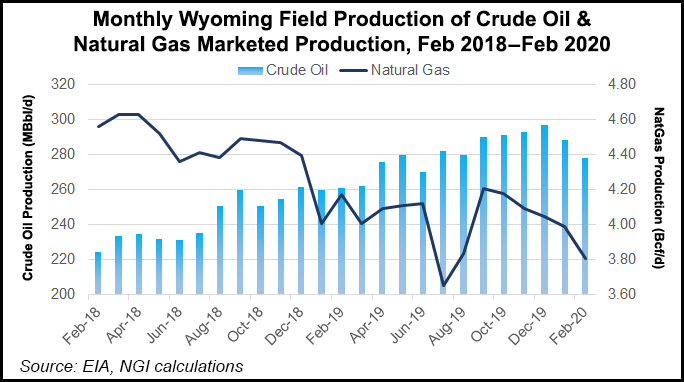Shale Daily | E&P | NGI All News Access | Regulatory
Wyoming E&P Group Takes Aim at Enviro Report Criticizing BLM Leasing
A Wyoming oil and gas industry group has sharply criticized a report by an environmental organization that slammed federal land leases for prioritizing them for alleged single use development by the oil and gas industry.

The Wyoming Outdoor Council (WOC) in its Public Lands Report Part I issued last week accused the Department of Interior’s Bureau of Land Management (BLM) of prioritizing the leases, which would go against the congressional standard for balancing the land for multiple uses, which range from recreational outdoor activities to industrial development, which includes oil and gas production.
At the same time, the WOC report criticizes oil and gas exploration and production (E&P) companies for leaving the leased land untouched, which the researchers claim blocks the public from these areas without producing economic stimulation for taxpayers.
PAW communications director Ryan McConnaughey told NGI that “WOC often repeats the fallacy that an increase in leasing equates to an equal rise in surface disturbance and shuts the public out of federal lands. Then in the next breath, WOC criticizes that leased acres are not being developed fast enough for them. WOC cannot have it both ways. Actual surface disturbance in Wyoming is a tiny fraction of the land area, and only those lands close to active drilling and even closer to completed wells are closed to public access. That is the picture of multiple-use.
“While WOC can raise money using incendiary language like ”indiscriminate’ or ”speculative’ leasing, the truth is the BLM does not offer federal mineral leasing indiscriminately. Acres are nominated for lease by operators because they believe there is development potential,” McConnaughey continued.
Many BLM auctions allow bidding to begin at the minimum of $2/acre, but once leased by an E&P, there is a yearly rental fee on all land, as well as an additional fee on unused land.
In 2018, oil and gas production in Wyoming contributed to $5 billion in economic activity, and further supplied $1.39 billion in property and severance taxes. Property taxes from Wyoming oil and gas companies account for 33% of the state’s total property taxes.
Wyoming had 361 companies and operators producing crude oil in 2018, and 227 were producing natural gas. Of the 25,605 producing wells in the state, 10,967 produced oil, and 14,638 wells produced gas. Of the gas-producing wells, 5,870 were coalbed methane wells.
Average production from Wyoming wells is small compared to other energy producing states, with 21.9 b/d of oil and 298 Mcf/d of natural gas.
As for the environmental impact, the WOC is concerned with the impact by E&Ps on the preservation of cultural and historic sites, such as the Oregon Trail. The WOC report also claims that BLM leases endanger mule deer and greater sage grouse habitats, putting them at significant risk.
The solution that WOC provides is to implement further legally binding stipulations on BLM leases. During the mating season of the sage grouse, however, PAW said oil and gas activity “comes to a halt” to support the repopulation of the endangered species.
McConnaughey told NGI “the oil and natural gas industry is one of the most heavily regulated industries in the world. Operators comply with a multitude of federal, state and local regulations designed to protect and mitigate disturbance to the land, water, air, wildlife, and cultural resources.
“While WOC would have people believe a well could be drilled in the middle of the Oregon Trail, or other significant cultural sites, they know perfectly well that both the National Trails System Act and the National Historic Preservation Act prohibit such action. They also know that Wyoming’s sage grouse strategy has been extraordinarily successful incentivizing development outside of core areas and that roads and subdivisions are much more damaging to large game wildlife corridors than careful natural gas development.”
In addition, “the industry is continually integrating new technologies to reduce impacts to the natural environment,” McConnaughey said. “As technology advances, our industry can produce more natural resources while minimizing the disturbance to surface lands. Our members strive to be good neighbors with communities and the natural landscape while delivering the energy that heats our homes and fuels our lives.”
© 2024 Natural Gas Intelligence. All rights reserved.
ISSN © 2577-9877 | ISSN © 2158-8023 |
